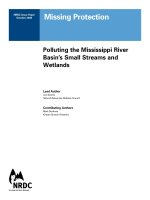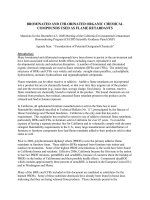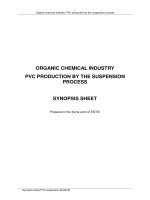Water-Quality Data from Semipermeable-Membrane Devices and Polar Organic Chemical Integrative Samplers Deployed in the McKenzie River Basin, Oregon pptx
Bạn đang xem bản rút gọn của tài liệu. Xem và tải ngay bản đầy đủ của tài liệu tại đây (508.78 KB, 14 trang )
Prepared in cooperation with the Eugene Water and Electric Board
Water-Quality Data from Semipermeable-Membrane
Devices and Polar Organic Chemical Integrative Samplers
Deployed in the McKenzie River Basin, Oregon
U.S. Department of the Interior
U.S. Geological Survey
Data Series 692
Water-Quality Data from Semipermeable-Membrane
Devices and Polar Organic Chemical Integrative
Samplers Deployed in the McKenzie River Basin,
Oregon
By Kathleen A. McCarthy and David A. Alvarez
Prepared in cooperation with the Eugene Water and Electric Board
Data Series 692
U.S. Department of the Interior
U.S. Geological Survey
U.S. Department of the Interior
KEN SALAZAR, Secretary
U.S. Geological Survey
Marcia K. McNutt, Director
U.S. Geological Survey, Reston, Virginia: 2012
For more information on the USGS—the Federal source for science about the Earth, its natural and living
resources, natural hazards, and the environment, visit or call 1–888–ASK–USGS.
For an overview of USGS information products, including maps, imagery, and publications,
visit />To order this and other USGS information products, visit
Any use of trade, product, or firm names is for descriptive purposes only and does not imply endorsement by the
U.S. Government.
Although this report is in the public domain, permission must be secured from the individual copyright owners to
reproduce any copyrighted materials contained within this report.
Suggested citation:
McCarthy, K.A., and Alvarez, D.A., 2012, Water-quality data from semipermeable-membrane devices and polar
organic chemical integrative samplers deployed in the McKenzie River basin, Oregon: U.S. Geological Survey Data
Series 692, 6 p.
iii
Contents
Abstract 1
Introduction 1
Environmental Setting and Data‑Collection Sites 1
Sample Collection, Laboratory Methods, and Quality Assurance 1
SPMD and POCIS Data 1
References Cited 3
Appendix 1. Data from Passive Samplers Deployed in the Mckenzie River Basin, Oregon,
During 2007. 5
Appendix 2. Data from Passive Samplers Deployed in the Mckenzie River Basin, Oregon,
During 2010. 5
Figures
Figure 1. Map showing study area location and data‑collection sites, McKenzie River
basin, Oregon …………………………………………………………………… 2
iv
Conversion Factors, Datum, and Acronyms
Conversion Factors
Inch/Pound to SI
Multiply By To obtain
inch (in.) 2.54 centimeter (cm)
foot (ft) 0.3048 meter (m)
mile (mi) 1.609 kilometer (km)
square mile (mi
2
) 2.590 square kilometer (km
2
)
gallon (gal) 3.785 liter (L)
gallon (gal) 0.003785 cubic meter (m
3
)
SI to Inch/Pound
Multiply By To obtain
centimeter (cm) 0.3937 inch (in.)
meter (m) 3.281 foot (ft)
kilometer (km) 0.6214 mile (mi)
square kilometer (km
2
) 0.3861 square mile (mi
2
)
liter (L) 0.2642 gallon (gal)
cubic meter (m
3
) 264.2 gallon (gal)
nanogram (ng) 35.27 × 106 ounce, avoirdupois (oz)
picogram (pg) 35.27 × 109 ounce, avoirdupois (oz)
Datum
Horizontal coordinate information is referenced to the North American Datum of 1983 (NAD 83).
Acronyms
CERC Columbia Environmental Research Center
DEET
N,N‑diethyltoluamide
DEHP Diethylhexylphthalate
EEQ Estradiol equivalent
EST Environmental Sampling Technologies, Inc.
EWEB Eugene Water and Electric Board
HCB Hexachlorobenzene
MDLs Method detection limits
MQLs Method quantification limits
NQ Not quantified
PAH Polycyclic aromatic hydrocarbon
PBDE Polybrominated diphenyl ether
PCA Pentachloroanisole
PCB Polychlorinated biphenyl
POCIS Polar organic chemical integrative sampler
PRC Performance reference compound
QC Quality control
RSD Relative standard deviation
SEC Size exclusion chromatography
SPMD Semipermeable membrane device
USGS U.S. Geological Survey
Water-Quality Data from Semipermeable-Membrane
Devices and Polar Organic Chemical Integrative Samplers
Deployed in the McKenzie River Basin, Oregon
By Kathleen A. McCarthy and David A. Alvarez
Abstract
Two types of passive samplers—the semipermeable
membrane device (SPMD) and the polar organic chemical
integrative sampler (POCIS)—are being used to collect data
from the McKenzie River, Oregon. The McKenzie River is the
source of drinking water for the City of Eugene, Oregon, and
passive-sampler data are part of an ongoing monitoring effort
designed to help understand and protect the drinking water
source. Data from the passive samplers are reported here. This
data report is dynamic and will be appended with additional
data as they become available.
Introduction
The McKenzie River is the source of drinking water
for approximately 200,000 people in the Eugene area of
Oregon (g. 1). To protect this source, the Eugene Water and
Electric Board (EWEB) has implemented a source protection
program (Eugene Water and Electric Board, 2000) that
includes monitoring water in the McKenzie River basin for the
presence of anthropogenic organic compounds.
Among the organic compounds of interest to EWEB
are many that may have human-health consequences at
concentrations that are orders of magnitude less than the
detection limits associated with conventional water-sampling
techniques. In addition, many compounds of interest may be
present only during episodic events. Two types of passive
samplers—the semipermeable membrane device (SPMD) and
the polar organic chemical integrative sampler (POCIS)—are
being used to address these particular challenges. Both the
SPMD (Huckins and others, 2006) and POCIS (Alvarez and
others, 2004, 2007) samplers are well suited to overcoming
the difculties of measuring low analyte concentrations and
recording episodic analyte loading.
This report presents data obtained from SPMD and
POCIS samplers deployed as part of a cooperative study being
conducted by the U.S. Geological Survey and EWEB. This
report is dynamic, and additional appendixes will be added as
new data become available.
Environmental Setting and
Data-Collection Sites
The environmental setting of the McKenzie River basin
and a discussion of sampling sites in the basin have been
previously reported in McCarthy and others (2009) and Kelly
and others (2012).
Sample Collection, Laboratory
Methods, and Quality Assurance
The methods used to collect, prepare, and analyze
samples and to assure the quality of the data are presented
in detail in McCarthy and others (2009). Methods are
briey summarized and details specic to each data set are
included as a “methods” worksheet in the data workbooks
(see appendixes).
SPMD and POCIS Data
The SPMD and POCIS data are available in the
appendixes of this report as Microsoft
©
Excel 2007 (.xlsx) les
at
2 Water-Quality Data from Semipermeable-Membrane Devices and Polar Organic Chemical Integrative Samplers, McKenzie River Basin, Oregon
tac12-0735_fig01
Western Cascades
High
Cascades
Willamette
Valley
126
228
99
58
22
20
20
5
5
126
Blue
River
Reservoir
McKenzie
Trail
Bridge
Reservoir
Cougar
Reservoir
Carmen
Reservoir
Lookout
Point Lake
Fall Creek
Reservoir
Clear
Lake
River
1,2
3
4
5
6
1,2
3
4
4
6
5
EXPLANATION
Monitoring location
Physiographic province
Basin boundary
High
Cascades
Eugene
Springfield
Leaburg
Vida
Coburg
Walterville
Belknap
Springs
121°45'122°122°15'122°30'122°45'123°123°15'
44°
30'
44°
15'
44°
0 5KILOMETERS
0
5 MILES
OREGON
Study
Area
Base modified from U.S. Geological Survey (various scales)
Projection: Oregon Lambert, North American Datum 1983
0 2
KILOMETERS
0 2 MILES
0 2
KILOMETERS
0 2 MILES
Inset 1
Sites 1-4
Inset 2
Sites 5-6
See “Inset 1”
Sites 1-4
See “Inset 2”
Sites 5-6
Figure 1. Study area location and data‑collection sites, McKenzie River basin, Oregon.
References Cited 3
References Cited
Alvarez, D.A., 2010, Guidelines for the use of the
semipermeable membrane device (SPMD) and the
polar organic chemical integrative sampler (POCIS) in
environmental monitoring studies: U.S. Geological Survey,
Techniques and Methods 1–D4, 28 p. (Also available at
/>Alvarez, D.A., Cranor, W.L., Perkins, S.D., Clark, R.C.,
and Smith, S.B., 2008a, Chemical and toxicological
assessment of organic contaminants in surface water using
passive samplers: Journal of Environmental Quality, v. 37,
p. 1024-1033.
Alvarez, D.A., Cranor, W.L., Perkins, S.D., Schroeder,
V.L., Werner, S.L., Furlong, E.T., and Holmes, J., 2008b,
Investigation of organic chemicals potentially responsible
for mortality and intersex in sh of the North Fork of the
Shenandoah River, Virginia, during spring of 2007: U.S.
Geological Survey Open-File Report 2008-1093, 16 p.
(Also available at />ofr20081093.)
Alvarez, D.A., Huckins, J.N., Petty, J.D., Jones-Lepp, F.,
Stuer-Lauridsen, F., Getting, D.T., Goddard, J.P., and
Gravell, A., 2007, Water sampling—Polar organic chemical
integrative sampler (POCIS), in Greenwood, R., Mills,
G., and Vrana, B., eds., Passive sampling techniques in
environmental monitoring, 48: Amsterdam, Elsevier,
p. 171–198.
Alvarez, D.A., Petty, J.D., Huckins, J.N., Jones-Lepp, T.L.,
Getting, D.T., Goddard, J.P., and Manahan, S.E., 2004,
Development of a passive, in situ, integrative sampler for
hydrophilic organic contaminants in aquatic environments:
Environmental Toxicology and Chemistry, v. 23, no. 7,
p. 1640–1648.
Eugene Water and Electric Board, 2000, Drinking water
protection plan: Eugene, Oreg., Eugene Water and
Electric Board Technical Report, 23 p., accessed April 20,
2012, at />WaterProtectionPlan.pdf.
Huckins, J.N., Petty, J.D., and Booij, K., 2006, Monitors of
organic chemicals in the environment—semipermeable
membrane devices: New York, Springer, 223 p.
Keith, L.H., 1991, Environmental sampling and
analysis—A practical guide: Boca Raton, Fla., CRC Press,
Inc., p. 101-113.
Kelly, V.J., Anderson, C.W., and Morgenstern, Karl, 2012,
Reconnaissance of land-use sources of pesticides in
drinking water, McKenzie River, Oregon: U.S. Geological
Survey Scientic Investigations Report 2012-5091, 46 p.
(Also available at />McCarthy, K.A., Alvarez, David, Anderson, C.W., Cranor,
W.L., Perkins, S.D., and Schroeder, Vickie, 2009,
Evaluation of passive samplers for long-term monitoring of
organic compounds in the untreated drinking water supply
for the City of Eugene, Oregon, September–October 2007:
U.S. Geological Survey Scientic Investigations Report
2009–5178, 20 p. (Also available at />sir/2009/5178/.)
Petty, J.D., Orazio, C.E., Huckins, J.N., Gale, R.W., Lebo,
J.A., Meadows, J.C., Echols, K.R., and Cranor, W.L., 2000,
Considerations involved with the use of semipermeable
membrane devices for monitoring environmental
contaminants: Journal of Chromatography A, v. 879,
p. 83-95.
4 Water-Quality Data from Semipermeable-Membrane Devices and Polar Organic Chemical Integrative Samplers, McKenzie River Basin, Oregon
This page intentionally left blank.
Appendixes 5
Appendix 1. Data from Passive Samplers Deployed in the Mckenzie River Basin,
Oregon, During 2007.
Appendix 1 is a Microsoft© Excel spreadsheet and is available for download at />Appendix 2. Data from Passive Samplers Deployed in the Mckenzie River Basin,
Oregon, During 2010.
Appendix 2 is a Microsoft© Excel spreadsheet and is available for download at />6 Water-Quality Data from Semipermeable-Membrane Devices and Polar Organic Chemical Integrative Samplers, McKenzie River Basin, Oregon
This page intentionally left blank.
Publishing support provided by the U.S. Geological Survey
Publishing Network, Tacoma Publishing Service Center
For more information concerning the research in this report, contact the
Director, Oregon Water Science Center
U.S. Geological Survey
2130 SW 5th Avenue
Portland, Oregon 97201
Printed on recycled paper
McCarthy and others— Water-Quality Data from Semipermeable-Membrane Devices and Polar Organic Chemical Integrative Samplers, McKenzie River Basin, Oregon—Data Series 692









